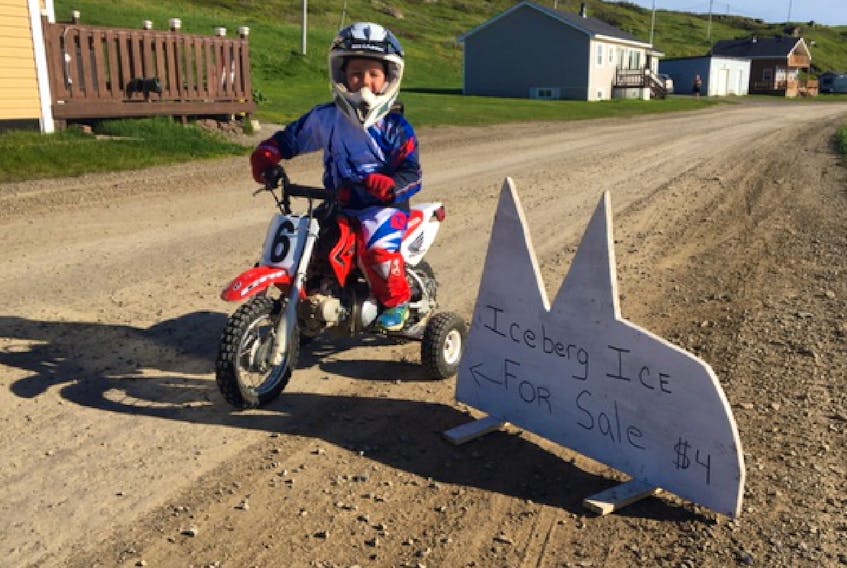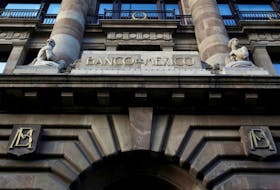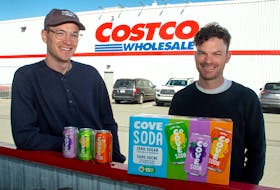David Meyers, the chief executive of Canadian Iceberg Vodka, a spirit made with water harvested from icebergs off Newfoundland’s coast, was meeting with a colleague at his office in Toronto’s northeast end on a snowy February morning, when the phone rang.
John Batten, the company’s warehouse manager in Port Union, Nfld., was on the line. He sounded baffled and bewildered, beset by a crisis he didn’t have an answer for. He had been doing his rounds, he explained, checking on the facility’s 30,000-litre iceberg water storage tanks to ensure the pressure gauges were all at 50, indicating the water inside was still circulating, instead of frozen solid.
But one of the pumps was registering zero and one of the pipes was displaced. Upon further inspection, the tank was empty and some $12,000 worth of iceberg water was gone.
“It is not like the tank leaked out,” Meyers recalled recently. “One of the pipes was askew, a pipe that should have been connected to a pump, so it appears the thieves attached a hose to that and drained it out, somehow. To be honest, we’ve been scratching our heads around here ever since.”

Police in Newfoundland continue to investigate the iceberg water whodunit, a heist that made international headlines and went viral on social media, but have yet to produce any concrete leads. What makes the mystery so appealing is the substance that was stolen: a precious liquid, of sorts, tapped from massive hunks of floating ice that, in their immensity, exude an almost mythic quality.
Icebergs are ancient history, indeed. They come to Newfoundland and Labrador from a seemingly distant place (Greenland, actually), buoyed along by the ocean current, melting beneath the summer sun and bleeding away perceived riches — that is, 100-per-cent pure, pre-Industrial Age, no vitamins-or-minerals-added iceberg water — into the Atlantic.
It is the iceberg’s size, length of journey, age (they are more than 10,000 years old), ever-shifting architecture and inevitable death that draws hundreds of thousands of vacationers to Newfoundland each summer to see them. They are a star attraction — right up there with whales, seabirds, lighthouses, hiking trails and the welcome-you-with-open-arms-and-distinct-accent Newfoundlanders — that drives a half-billion-dollar-a-year tourism industry.
But icebergs also serve a lesser-known purpose: as muse to a handful of hopers, billionaires and kooks, whose iceberg water-based concoctions — be they vodka, bottled water, age-defying face creams, craft beer, wine and whatever they might think of next — fuel an industry built upon the faith that berg water is the tip of a commercial iceberg, an imagined gateway to great riches.
The industry has attracted a Saudi prince, failed politicians and former beach bums despite having just one certainty: the natural resource it relies upon disappears by September 1, only to return anew the following year, when another batch of bergs, typically 400 to 800 a season, drifts down Newfoundland’s coast for tourists to behold — and dreamers and schemers to try to profit from.
Money, mind you, is not a factor in Steve Bruneau’s fascination with icebergs. He’s an engineering professor at Memorial University in St. John’s, and a world-renowned expert on Arctic ships and structures — such as oil drilling platforms — which means he thinks a lot about ice and icebergs.

Bruneau has tested iceberg water, and can attest to its purity and the relative accuracy of the hyperbole often adopted by those trying to sell it.
“Ice was hard to come by in Newfoundland 200 and 300 years ago, and so icebergs were used quite regularly as a source of ice for packing fish and preservation,” he said.
“What is new about it today is that people are going after iceberg ice strictly for the novelty aspect of it. It sounds good, the optics are pretty cool and you got these big old blocks of ice cracking off the glacier — and we can say that the water is as pure as the driven snow and unaffected by modern civilization, and all that stuff, and that’s all pretty well true. But make no mistake: it is a novelty, and people like that.”
Unlike other Newfoundland novelties, such as being screeched in at the pub, the iceberg industry is not for the financially or physically faint of heart.
Harvesting ice from an iceberg requires a heavy-duty, reinforced-steel-hulled boat, and a spirit of derring-do to pull up alongside a hunk of ice that can split or unexpectedly flip, and often features sharp, spiny underwater fingers of ice, capable of punching holes through unsuspecting watercraft. (Remember the Titanic?)
In this regard, Ed Kean numbers among the elder statesmen of the iceberg industry, a veteran of 30-plus summers of harvesting ice. He has a break-your-hand-in-two-handshake grip, and he got into the iceberg business because his family business was built upon a fishery that collapsed. Kean didn’t want to leave Newfoundland for someplace else, so he had to find something new to fish for.
Icebergs were it.
“This is a very small industry,” Kean said from the mountains of western Newfoundland, where he was snowmobiling. “It is costly to get into, and you’ve got to harvest enough ice in two months to last the rest of the year.”
In the olden days, Kean cracked ice chunks off larger icebergs by blasting them with a rifle, or hacking into them with an axe, then scooping up the pieces with a net. His system is more advanced now.
Kean harvests about 1,000 tons of ice a summer — Iceberg Vodka is by far his largest client — using a 100-foot-long custom barge, aptly named the Ice Harvester, outfitted with a grappling hook. The grapple breaks off ice chunks, which are fed into an ice grinder and then stored in tanks. The ideal iceberg for harvesting is about the size of a medium-sized house.
“I am starting to do my own iceberg water now,” said Kean, one of six individuals/companies licensed by the province to harvest icebergs. “I am hoping that it is going to be bigger than the vodka, bigger than the beer — and everything else.”
Hopes and dreams are the underpinnings of an industry that was always supposed to be bigger than what it has actually become.
The idea of monetizing iceberg water first cropped up in the late 1940s, thanks to John Dove Isaacs III, an American scientist and academic.

Isaacs’ career arc took him from being present at nuclear test sites and studying blast waves, to hypothesizing that towing Antarctic icebergs up the Pacific Coast and anchoring them off Catalina Island might solve California’s chronic water scarcity problem in the agro-industrial sector.
His theory was completely wacky, and resided on the scientific margins until the 1970s, when Saudi Prince Mohammed bin Faisal Al Saud became interested in icebergs as a possible answer to his country’s drinking water problems.
With Saudi money to be made in icebergs, university professors started cranking out papers and convening academic conferences. Entrepreneurs took note.
“Previous discussions of iceberg water had stressed its application to irrigation and agro-industrial complexes, schemes that could not afford high-priced water — and demanded delivery of very large icebergs,” American geophysicist W.F. Weeks noted to his peers at a gathering of the International Glaciological Society in Cambridge, England, in April 1980.
“Water delivered to Saudi Arabia, however, would be used for human consumption and high technology, and could command far greater prices.”
Saudi iceberg interest also caught the eye of Ron Stamp, a former owner of a hovercraft rental business in the Cayman Islands and a St. John’s native. He just couldn’t understand why the Saudis wouldn’t just melt the iceberg wherever it was, bottle the water and ship it home, ready to drink, rather than towing an iceberg to the desert — which never actually happened.
“Commercially, the prince was looking at the most expensive ice cube on the planet,” he said. “And that always stuck in my head.”
Stamp fancies himself Canada’s original iceberg water entrepreneur. As he tells the story, he was drinking beers with some buddies, circa 1982, when they started talking about that iceberg-obsessed Saudi prince.
Stamp had left home at 17 to drive a truck in Toronto, before realizing that what he was really good at was talking, and so he switched to sales before leaving sales to be a beach bum in Jamaica.
Next came the hovercrafts and, ultimately, a trip home to visit his parents, where he started a new venture: selling Newfoundland fish to Europe. It was a fine idea, until the cod all but disappeared and the government declared a moratorium on the fishery.
All the while, Stamp said, he never forgot about the Saudis, or the image of a giant iceberg melting away, which served as inspiration for his first iceberg-related business idea: iceberg ice cubes.
Pure, hard and slow to melt, iceberg ice cubes had an origin story he felt a connoisseur of fine Scotch would swallow, and pay a premium for. But the idea never took off. Instead, vodka was the answer.
“I was the first person to make a vodka out of an iceberg or bottled water out of an iceberg, and that can’t be taken back from me,” Stamp said.

His vodka-making days date back to about 1993, and are long past now, though his latest creation — Borealis, an iceberg beer — has him telling stories again. The beer has been test-marketed in several Asian markets to, its creator claims, rave reviews.
“I’ve been looking at icebergs all my life,” Stamp said. “It’s a funny thing, because no matter how often you see them — if you are driving along the coast and you pop around a corner and there is an iceberg — it’ll make you stop. They are off-kilter, because it will be summer, and then here is this chunk of ice, hanging on the horizon. They are an amazing thing.”
Which is why some Newfoundlanders would prefer that the iceberg harvesting crowd simply left the icebergs alone.
“Getting into a conflict with the harvesters — that kind of a scenario — it is real,” said Cecil Stockley, who operates MV Iceberg Alley, an iceberg/whale-watching vessel out of Twillingate, N.L. “My opinion was, and always has been, that we should allow an iceberg to break down naturally. Tourists, especially in a place like Twillingate, the last thing you want to see is the harvesters crunching up an iceberg with all their machinery.”
In years past, tensions flared between the harvesters and the preservationists. Shouts and insults were exchanged between boats. Things, Stockley admits, could easily have escalated.
To keep the peace, the Newfoundland government stepped in, adopting a series of iceberg/whale-watching industry-friendly measures, including stipulating that all iceberg “harvesting activities shall not interfere with tour boat operations or other recreational activities …
“Also, harvesting activities or collection of bergy bits shall not be carried out within visible distance from known locations frequented by tourists, including, but not limited to, Cape Bonavista, Cape Spear, Twillingate and other locations …”
For now, the iceberg détente remains, and the icebergs continue to attract new dreamers to the industry.
One such dreamer is Marek Krol, a Polish-Canadian entrepreneur famous around Newfoundland, in the utmost small-c celebrity way, for starring in his own, short-lived reality television series called Living Wild, about living off the land with his family.
The 52-year-old leveraged his celebrity to try his hand at politics, standing as a Conservative candidate in St. John’s in the 2015 federal election against Liberal star, Seamus O’Regan. Krol got crushed, earning just 4.5 per cent of the vote.
“Politics didn’t work out so well for me,” he said, laughing.
Next up: iceberg vodka, perhaps iceberg water and, who knows, maybe iceberg water-derived medicine of some sort.

Krol claims he is on the cusp of patenting a new technology that will dramatically increase the volumes and efficiencies involved in iceberg harvesting. He is also engineering a new vodka bottle — no sneak previews allowed — that he expects will be on liquor store shelves across Newfoundland this fall.
“Success starts with a dream,” he said. “Amazing people who become billionaires, they have a dream and they pursue it, and I am not afraid to take a risk, to dream big and to make things happen.”
Back at Canadian Iceberg Vodka HQ in Toronto, another week has passed without any new breaks in the case of the missing iceberg water.
CEO David Meyers has his own working theory, believing that the thieves must have thought they were stealing vodka when they emptied the storage tank, before disappearing without a trace.
“Thirty thousand litres of vodka, that would have substantial value,” he said. “But there is no black market for iceberg water. What you do with 30,000 litres of stolen iceberg water in Newfoundland, I just don’t know.”
But maybe the thieves do know, and maybe they have known along. They wouldn’t be the first to look at an iceberg and see a 100-per-cent pure opportunity frozen inside.
By Joe O'Connor
• Email: [email protected] | Twitter: oconnorwrites
Copyright Postmedia Network Inc., 2019









